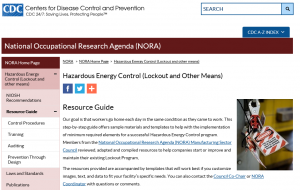Improving Programs to Control Hazardous Energy: New website offers tools and templates
Posted on byA new website from the National Occupational Research Agenda (NORA) Manufacturing Sector Council features ways in which businesses and companies can safeguard employees from the release of hazardous energy (any source of electrical, mechanical, hydraulic, pneumatic, chemical, thermal, or other energy) during service and maintenance activities. The new website features a resource guide with step-by-step guidance and customizable materials and templates to help implement effective strategies for controlling the release of unsafe hazardous energy. This website is a collaborative effort from the NORA Manufacturing Sector Council members. The resources were organized for key components of a program, and include:
 – Links to regulatory requirements, best practice information and sample written programs;
– Links to regulatory requirements, best practice information and sample written programs;
– Templates for posters and signs, area diagrams, and clarification of procedures;
– Links to tutorials, training materials, lesson plans and sample introductory PowerPoint presentations;
– Template forms for auditing of the program; and
– Links to resources from existing standards and prevention through design methods.
How did these resources come to be?
For decades, NIOSH has recognized that controlling of hazardous energy can protect workers. Injuries and sometimes deaths can result from the sudden release of stored energy, or can occur when an employee services or repairs a machine or tries to clear a jam without de-energizing the machine and locking out sources of energy. In 1999, NIOSH issued recommendations to protect workers from hazardous energy releases that occur during the installation, maintenance, service, or repair of machines, equipment, processes, or systems. These steps, often referred to as “lockout/tagout” procedures, still form the basis of NIOSH recommendations related to control of hazardous energy. However, failure to develop and use hazardous energy control procedures remained one of OSHA’s annual top 10 most frequently cited workplace safety violations.
In 2008, OSHA contacted staff from NIOSH and the University Of Cincinnati Department Of Environmental Health with the concern that fatalities and injuries related to hazardous energy release were still occurring. OSHA wanted to clarify regulations related to the application of the Lockout/Tagout Standard. This collaboration resulted in an OSHA training course, OSHA Course 7115. NIOSH followed up with a Workplace Solutions document in 2011 to reinforce OSHA regulations and NIOSH recommendations.
Around that time, NIOSH was in the middle of its second decade of the National Occupational Research Agenda (NORA). NORA is a partnership program to stimulate innovative research and improved workplace safety and health practices. NORA partners include stakeholders from universities, large and small businesses, professional societies, government agencies, and worker organizations. This group exchanged information and ideas towards the identification of safety and health issues that should be priorities for further work. Some members of the Manufacturing Sector Council co-authored the NIOSH Science Blog A Wrench in the Gear: Lockout/tagout in the food industry. The blog communicated the Council’s intent to help small manufacturers with the control of hazardous energy, and asked for public input to enhance our understanding of the issues surrounding lockout programs. The blog received 166 comments and after posting the blog, members of the Council compiled, reviewed, and adapted resources to help companies and businesses start or improve and maintain their hazardous energy control interventions. The Council leadership then sought peer review by NIOSH and external experts to further improve the materials currently found on the new website.
We are interested in your input on the new website and the resources it shares! Please use the comment section below. Also, send us any questions or input about your needs for lockout-tagout and hazardous energy control.
To access the new website, visit: https://www.cdc.gov/nora/councils/manuf/loto/default.html
To learn more about the NORA Manufacturing Sector Council, visit: https://www.cdc.gov/nora/councils/manuf/default.html
Richard S. Current, PE, is a Research Safety Engineer in the NIOSH Division of Safety Research.
Thais C. Morata, PhD, is a research audiologist with the NIOSH Division of Applied Research and Technology and the Coordinator of the NORA Manufacturing Sector Council.
Frank Renshaw, PhD, is the managing member at Bayberry EHS Consulting, LLC and the National Occupational Research Agenda (NORA) Manufacturing Sector Council Co-Chair.
Susan Afanuh, MA, is a Technical Information Specialist in the NIOSH Education and Information Division.
Nura Sadeghpour, MPH, is a Health Communication Specialist in the NIOSH Communication and Research to Practice Office.
Posted on by

